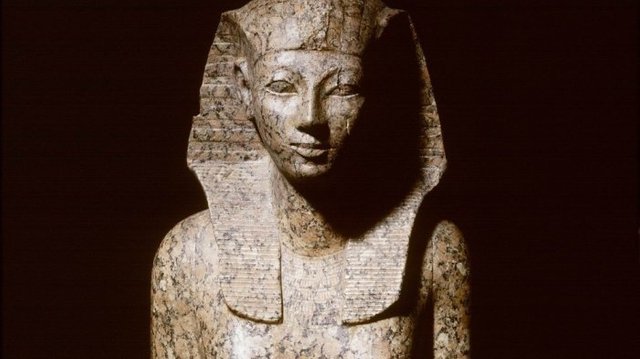Hatschepsut, the Pharaoh Woman who Builds Her Own Tomb Temple.

The modern world knows Cleopatra as a pharaoh woman. Apparently long before that, Egypt had been ruled by a woman who was no less intelligent.
Hatschepsut's name, ruled from 1515 - 1484 BC. During his reign Egypt experienced a period of prosperity.
We see how Hatschepsut's government was, as it was published in the September 1999 issue of Intisary Magazine, with the original title Hatschepsut the Pharaoh Woman.
Hatschepsut was still nine years old when he together with Thebe residents crowded the banks of the Nile to welcome Thutmois I who returned to bring victory from the battle in Nubia.
He was invited by Queen Ahmes, along with his other children. Hatschepsut is thin, too small for a child his age, but with an interesting face.
His days were filled with school activities, studying with relatives and children of palace officials. After reading and writing, he memorized the teachings of the court advisers of Ptahotep and Kagemi, even if he controlled kemit, the oldest official world history book written 500 years before his birth.
He diligently studied ancient language texts and learned to write letters. Anyway, everything that a king needs.
Not approved because of women.
Historical books allegedly aroused his desire to rule. Especially the story of Nitocris, the pharaoh's woman who rode 700 years before. That said, with pink cheeks and blond hair, Nitocris became the most beautiful woman of its time.
More than that, the rigidity is not inferior to male pharaohs. Even after her husband was killed, she drowned the palace where her husband's murderers were partying.
Whether it's true or not, the story above is in the history book. What is clear, Hatschepsut admires him. He is also very proud of his grandmother, Ah-Hotep who led the war with his two sons, and even dominated the Hyksos domination of 200 years.
But Hatschepsut's happiness suddenly collapsed. When he was 12 years old, two of his siblings died, followed by the death of his brother, Amunmose, the crown prince. Stay as the only child of the pharaoh.
The father had no choice but to lift Hatschepsut as heir. At the age of 15, he was married to his half-brother, Thutmosis, son of the pharaoh of the concubine Mutnofret. As old as the princess, Thutmosis also has a handsome face, 1.60 m tall, slim body, brown curly hair. He is friendly, but a claimant.
In 1494 BC, Thutmosis became Thutmosis II, when Thutmosis I died. Hatschepsut was 19 years old at the time.
Accompanied by the chants of priests and jingling bells, the six-year-old Karnak Temple was ordained by the king as a potential successor. For a while the pastors felt victorious.
Not long after Thutmosis II died of smallpox. Whatever struggle happened, on May 1, 1490 BC, when Thutmosis III officially ascended the throne, standing next to the little pharaoh as king's guardian was Hatschepsut. Not a priest.
Immediately after that, Hatechepsut carried out a number of political initiatives which he considered necessary. He appointed Deleteeneb and Puimre as the highest minister and urged them to make new predictions.
£Of course the prophecy he really wanted, namely that God Amun bestowed this royal honor on Hatschepsut.
Finally the road to the open throne. With a gorgeous robe, a chin with a "beard of lamb" (a symbol of shepherd), a hand holding a whip and a shepherd's rod, Hatschepsut was crowned Egyptian ruler. A pharaoh.
Although the date of coronation is not recorded, from that moment Hatschepsut's name can be found in a circular inscription, the pharaoh's emblem as the center of the cosmos. The official name of Hatschepsut is Maatkare.
He did not seize the throne as often mentioned. He even ruled over the blessing of Thutmosis, a pharaoh that must be obeyed, including priests.
Then he began to rebuild all the honcur in the colonial period of the Asian people (including the Hyksos). Improved statues and temples. He also built two monuments at the Temple of Karnak. He even built a temple for his own tomb at Deir-el-Bahri.
This smart woman modernizes state institutions, makes the kingdom stable, both inside and out.
In the ninth year of his administration, he sent a trading expedition team to Punt, allegedly Somalia now.
In public, Hatschepsut always wore men's clothing, even Ka, his spiritual symbol, was described as a young man. But basically he is still a woman who longs for love. For that there is Senmut.
The man entered the palace after the death of Hatschepsut's father. As a good government expert and organizer, his support is very helpful indeed. As an intellectual intellectual, he was born of the plan to build a temple for Hatschepsut at Deir-el-Bahri.
Even perhaps personal intimacy also prompted him to design a grave for himself in one of the rooms below the temple, so that even in eternity he would remain close to the Egyptian ruler. So don't be surprised if Hdtschepsut gives him office and wealth.
But in the 16th year of Hatschepsut's government, Senmut was rumored to be involved in corruption, abuse of power, and unfaithfulness. What happened to Senmut was sad, unclear. The tomb he made remained empty and he suddenly disappeared from the historical record.
In the same year Neferure died. Six years later, Hatschepsut followed him at the age of 45. After 22 years of rule, this woman leaves a strong government and an orderly state. Even his successor, Thutmosis III, recognized it as a successful pharaoh.
But slander continues to plague this strong woman. He is said to be the usurper of the throne, until many of his statues are destroyed by his successor. His tomb was empty when opened by Howard Carter in 1904 along with the discovery of Tutankhamun's tomb.
According to Egyptian cultural expert Angelika Tulhoff in Thutmosis III, the destroyer of his predicate was allegedly Ramses II (1250 BC), who was very anti-female figure as ruler of Egypt.
Source
@dewaled507